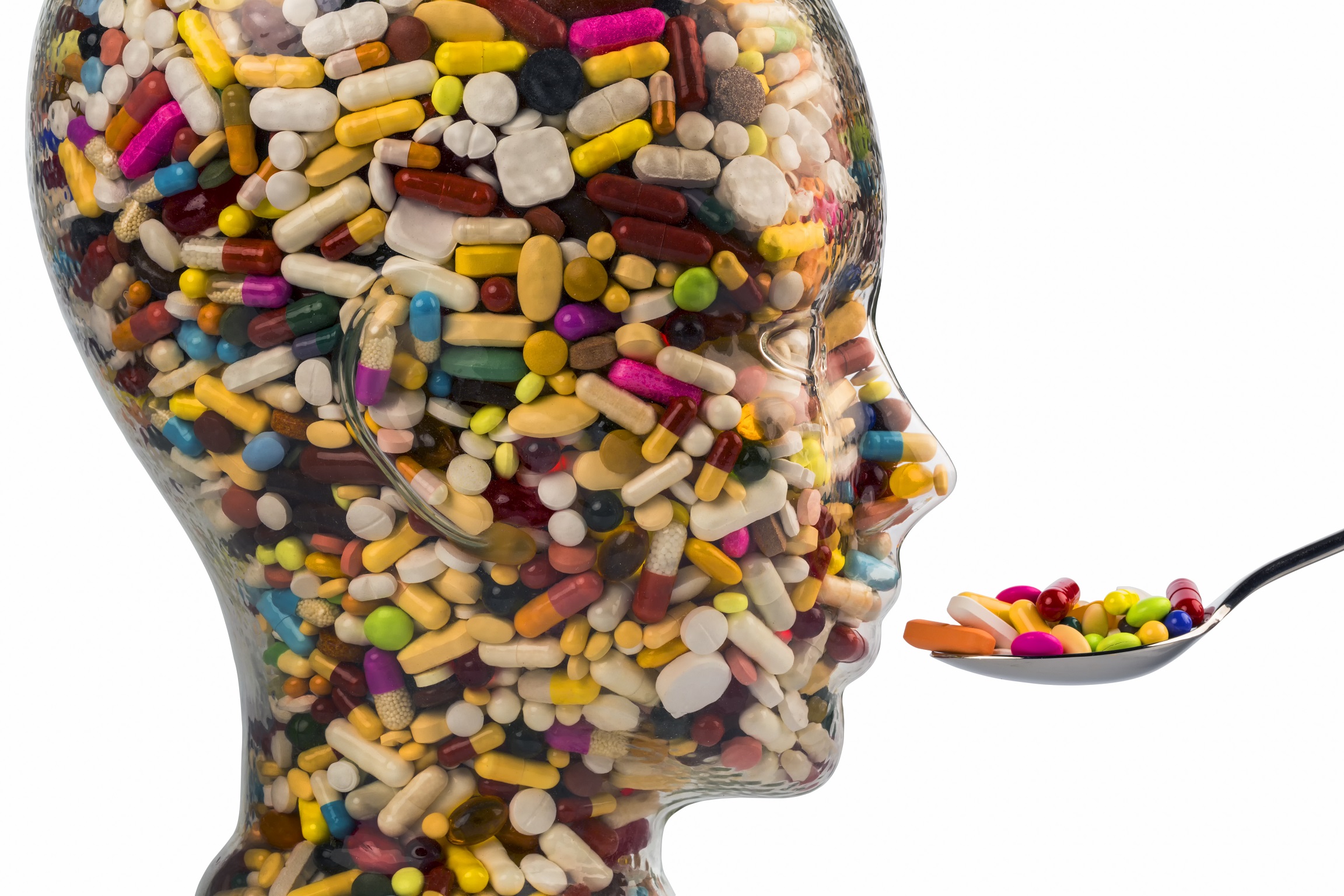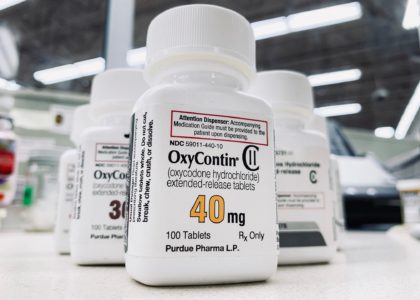
In countries of the developed West, the tendency to place unrealistic expectations and pressures on individuals to conform to ascetic social norms that demand overuse and abuse of our mind-brain mechanisms has resulted in some very palpable but negative ramifications. The most obvious albeit alarming is the romance afforded by the magic bullet, the erroneous and magical perception that somebody can wave a wand and dispel physical pain, psychological anguish, and whatever else has temporarily disturbed our harmonious inner order. Over and over again, authoritative figures will reassure us that over-the-counter analgesics like Panadol or Panamax (paracetamol) will quash the dreaded experience of pain, Valium and Librium (benzodiazepines) will reduce stress and anxiety levels, and Emadine or Livostin (antihistamines) will dissipate eye irritations caused by allergies. There’s a magic bullet for most things and we’re expected to live and die by it, or so we’re told.
By visiting your local pharmacy and perusing some of its shelves, you’ll be able to comprehend first-hand the comprehensive variety enabled by the unlikely marriage between an inherent human desire for wellness and ailment-free living, materialistic consumerism, and private pharmaceutical companies with lucrative aspirations. No doubt medical practitioners and other health care professionals with humanitarian streaks and ethical sensibilities about them are the real losers in this affair; bombarded with subliminal messages instructing them to endorse the capitalist status quo and to appease unconscious expectations, they unwittingly introduce their patients to a diabolical pill-popping factory through which a deleterious cycle of distressing side effects–adaptation, habituation, dependence and addiction, iatrogenic illnesses, and premature death may be incurred. So much for the esteemed and sacred Hippocratic oath! I, myself, prefer to liken the supposed benefits of pharmacological interventions to fool’s gold–once the novelty of the golden patina wears off, you’re left bobbing up and down like a cork in the same leaden and poisonous ocean that was before your ephemeral encounter with synthetic, state-altering drugs. In other words you’re at the foot of your problem again; back to the frightful beginning, the excruciating origin, to square one.
Prodigious medical interest in pharmacological agents was sparked in the early 1950s after Jean Delay, a reputed French psychiatrist, and his colleague Pierre Deniker decided to test the tolerability of chlorpromazine, known for its powerful sedative effects, on a series of psychotic patients at the Ste-Anne hospital in Paris. It was a therapeutic breakthrough of unprecedented and megalithic proportions, with clinical trials offering empirical support for chlorpromazine as an effective weapon in the long-term management of mental illness. Delay and Deniker’s publications confirmed that patients who were on the drug experienced a significant and dramatic reduction of psychotic symptoms like hallucinations and delusions, while those who decided to remain on it enjoyed fewer relapses than patients in the drug-free control group. Since that historic and serendipitous moment, drugs have become a fundamental force akin to a deadly virus like Ebola in biochemical warfare; modern psychiatry depends heavily on them to correct the cognitive deficits and perceptual gains of atypical mind-brain states such as those seen in schizophrenia, bipolar disorder, depression, and dissociative multiplicity, and medical practitioners and specialists deploy them to negate the symptomology of organic diseases like meningitis, tumours, and diabetes.
Biochemical research into pharmaceuticals has opened up a brave new world, a chemical world at that; we know that their therapeutic efficacy has undoubtedly revolutionized the diagnostic aspects and prospective treatments of contemporary medicine, but we have also ascertained that their mode of action is unspecific and for the most part problematic, leaving much to be desired. In the light of such an ambivalent reality, one cannot help but feel that the problematic nature of pharmaceutical agents should be properly comprehended and their overall ratio of benefits to detriments enumerated before we decide to accept or reject them as catalysts in the repossession of our own psychological and physical health. For that we need to acquire, at the very least, a rudimentary understanding of how natural chemicals called neurotransmitter molecules are produced and utilized by the nervous system and how synthetic drugs interrupt these physiological control mechanisms to yield desirable modifications in the subjective experience of ‘abnormal’ states.
Anybody tenuously acquainted with neuroscience will know that transfer of information in the nervous system occurs between specialized cells called neurons. Neurons themselves morphologically resemble trees and consist of a soma or cell body containing metabolic machinery; outstretched nerve branches that serve as input for incoming electrical messages called dendritesaxon, a single efferent projection whose purpose it is to pass information to the dendrites of other neurons. In a most fascinating phenomenon, the axon terminals projecting the encoded information and the nexus of dendrites receiving it never actually make physical contact. The vacant junction is called a synapse.
Perhaps a far more lucid and direct understanding of nerve cell linking is possible if we evoke a direct comparison with Michelangelo’s Creation of Adam fresco painting forming part of an interconnected iconographic scheme on the ceiling of the Sistine Chapel–just as the numinous spark of life passes from God’s outstretched finger to Adam’s finger by way of indiscernible supernatural agency, so too is information ferried across the synaptic junction in the complete absence of any physical apparatus. When a nerve cell wishes to convey an encoded message it will shoot chemical molecules called neurotransmitters into the junction, allowing the information to hitch a chemical ride across to the postsynaptic terminal of the afferent nerve cell. Receptors embedded on the surface of its membrane act as gatekeepers and will accept or reject incoming signals. Transfiguration in the shape of the receptor means the message has been accepted and transmuted into an excitatory effect that may be conducted along the afferent neuron as an action potential; alternatively inactivity at the receptor site translates to an inhibitory effect where the docking neurotransmitter is refused passage, kept afloat in the synaptic junction, and subsequently swallowed up by special enzymes.
Pharmaceutical agents enforce change at the chemical level of physiological function in one of three ways: they can closely mimic the molecular structure of a particular neurotransmitter so that the postsynaptic neuron is fooled into firing an action potential, called agonistic action; they can bind to specific receptors on postsynaptic terminals and inhibit neurotransmission, called antagonistic action; or they can operate via amalgamation of the two methods. To give an example or two, psychotropic drugs like heroin, methadone, and morphine are antagonistic in nature because they activate opioid receptors in the brain, naltrexone and naloxone are antagonists that block the same opioid effects by attaching to opioid receptors and inhibiting transmission, and the pharmacological taxonomy containing buprenorphine and butorphanol exhibit both agonistic and antagonistic properties.
Now all would bode well if drugs acted naturally in their manner of operation and enforced permanent changes at the fundamental genetic level, or if there was an ingenious way of containing a particular drug to one specific area of the human body after ingestion or inoculation. Sadly, drugs are synthetic products employing unnatural pathways of unspecific action. With respect to the latter, once the drug has entered the bloodstream it’s free to circulate and go anywhere–eyes, mouth, heart, stomach, and so forth. Even that superior fortification, a membrane known as the blood-brain barrier, cannot guarantee absolute sanctuary for the most delicate and vital organ, the human brain. Recreational drugs are notorious for their ability to penetrate this defence and change brain chemistry, often with disastrous consequences. More importantly perhaps, the principal neurotransmitters like serotonin, norepinephrine, and acetylcholine are intricately woven into a physiological control system that deploys each for the regulation of manifold psychical-somatic functions.
To norepinephrine, for example, is bequeathed the imperative cognitive task of attentional selectivity and concentration in the brain and the activation of the sympathetic branch of the autonomous nervous system. There’s a wide gamut of functions associated with the sympathetic nervous system: the suppression of appetite and digestion, the glandular effusion of adrenaline, the inhibition of blood flow to the genitals, the augmentation of heart rate and respiration, and a lot, lot more. It would make sense then to surmise that deficits in any of these cognitive or physical functions are intimately bound with significant decreases in the neuronal output of norepinephrine. Nowadays prescriptions of a mild amphetamine, a close chemical cousin of norepinephrine, is the pharmacological treatment of choice for psychiatrists attempting to reduce the disturbing motor movements of children suffering from attention deficit disorder. In the logic of modern psychiatric discourse the immediate suppression of random motor signals with these drugs makes possible volitional fixation upon a single one.
I have no reservations as to the potency of drug treatment–the amphetamines offer satisfactory short-term relief from undesirable symptoms by artificially stimulating the same neural pathways as norepinephrine, pathways which somehow facilitate the sharpening of attention in healthy individuals. But the whole endeavour takes on a much more ominous guise upon closer scrutiny; amphetamines may act altruistically in correcting the cognitive deficit of an abnormal state, however you can be more than certain that they will somehow disrupt any specific function with which its natural counterpart (norepinephrine) is chemically affiliated. With no way of localizing pharmacological action in the brain and body, we can expect multiple functions to be affected. And guess what, they are!
Clinical trials have revealed that minimal doses of amphetamine required for positive psychotropic action do come with some perturbing side effects–unrelenting alertness, irritability, insomnia, restlessness, an irregular heart rate, atypical breathing, hypertension, erectile dysfunction in males, and what not. You could probably expect the same or analogous detriments to arise if norepinephrine levels skyrocketed to double and triple figures. Scarier still is that we have at our disposal only limited knowledge of the nature, amplitude, and projective long-term course of side effects wrought by the existence of synthetic chemicals in the body. The aforementioned problem is foremost of the reasons as to why the conscientious and empathic doctor will only prescribe drugs as a last resort.
Then there’s the problem of adaptation or “down regulation.” The human body is incredibly efficient, economic, and adaptive when it comes to the modus operandi for chemical signalling. In optimal functioning neurons will keep moderate quantities of receptor sites open for business, enabling the swift transmission of signals (or not) along their axons when neurotransmitters arrive from local terminals. This evolutionary innovation of physiological control ensures that all incoming messages are attended to in swift fashion. Having said that possible excesses are rarely, if ever, construed as desired amenities–flood receptor sites with high concentrations of neurotransmitter or their artificial chemical cousins for protracted periods, and the former reconfigure so that the amount made available for chemical action decreases exponentially. This intrinsic capacity for learning at the cellular level is nothing short of commendable; why should a biological system expend metabolic energy in keeping innumerable receptor sites open for particular transmitters when the broadcast of corresponding signals has already been guaranteed? It seems pointless, and is.
At some point in evolutionary history Mother Nature must have cottoned on to this small glitch in our genetic makeup and acted in favour of economy in her apropos correction of it. All the same for many among us this constructive intercession has become a diabolical conspiracy. Just as your close circle of faithful listeners and supporters may turn a blind eye if you start to cry “wolf” too many times in your life, so too do your neurons desensitize to the “call” of chemical molecules when these are in perpetual effusion. When besieged by a chemical ocean receptor sites will remain sedentary, at least until local conditions improve. The implication for us mere mortals? Well, if we make the mistake of bombarding our nervous systems with the same drugs over and over and over again, we’re essentially throwing ourselves into the lethal arms of habituation.
In time the cognitive, emotional, and physical benefits facilitated by sustained drug use wane like the moon as all correlated neural networks gradually acclimatize to the artificial conditions. We increase the dosage in an attempt to recapture the same psychological and physical relief that we’d experienced with significantly lesser amounts in former trials–another Prozac pill, another puff of a cigarette, another intravenous injection of heroin, another sniff of cocaine or guzzle of red wine. By this stage the transitory switches in conscious states caused by the pharmaceuticals have robbed us of our propensity for analytical reasoning and judgement. Our minds have become enfeebled and scrambled, so much in fact that we’ve now deluded ourselves into believing that more of the respective chemical is the only solution to our problems. Without knowing it we’ve become addicted.
Nature’s pro-sentiments for economy and competence work against us in other ways too. When transmitter saturation becomes the predominant condition of any neural network, the efferent nerve cells responsible will cease production completely. From a conservative point of view, the decision to abort seems sensible; why should we keep making a product we don’t need in any immediate sense? Probing a little deeper though we see that this too poses a very significant problem for addicted individuals trying hard to abstain from drug use, or individuals being weaned off prescription drugs. It takes neurons responsible for transmitter output an indefinite period of time (days, weeks, months, etc.) to recommence production if commands from the Central Nervous System (CNS) spontaneously overturned the original decision. A temporary lag in the production of transmitter leaves the afferent networks shrieking and bellowing for excitation, a phenomenon bound to manifest on the psychological level as withdrawal. Anybody suffering from withdrawal will find that symptoms are relative to chemical quantity-the more excessive the prescribed dose, the more severe the withdrawal symptoms. The only escape, at least in the short-term, is to spray afferent neural networks starving for chemical transmitter with an artificial stand-in, a drug that will act upon the same receptor sites.
For a great many the instantaneous relief offered by recourse to drugs becomes too great a demonic temptation to resist and they capitulate, becoming nonconscious accomplices in the anomalous alteration of dynamic metabolic processes which buttress their own natural biorhythms. And for disturbing these natural biorhythms our bodies will impose the most horrendous punishment–they will thrust us into a wild chronological vortex, and, deprived of all our willpower, we shall find ourselves plummeting down to the realms of adaptation and habituation, lower still to the realms of dependence, addiction, and withdrawal, and, if we’re immensely unlucky, lower still to the dishonourable realm of premature death. It would therefore be wise if we pondered the effects of this noxious and often inescapable cycle before invoking it in our lives.









